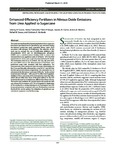Use este identificador para citar ou linkar para este item:
http://www.alice.cnptia.embrapa.br/alice/handle/doc/1013414Registro completo de metadados
| Campo DC | Valor | Idioma |
|---|---|---|
| dc.contributor.author | SOARES, J. R | pt_BR |
| dc.contributor.author | CANTARELLA, H. | pt_BR |
| dc.contributor.author | VARGAS, V. P | pt_BR |
| dc.contributor.author | CARMO, J. B. do | pt_BR |
| dc.contributor.author | MARTINS, A. A | pt_BR |
| dc.contributor.author | SOUSA, R. de M. | pt_BR |
| dc.contributor.author | ANDRADE, C. A. de | pt_BR |
| dc.date.accessioned | 2015-04-14T05:57:17Z | - |
| dc.date.available | 2015-04-14T05:57:17Z | - |
| dc.date.created | 2015-04-13 | pt_BR |
| dc.date.issued | 2015 | pt_BR |
| dc.identifier.citation | Journal of Environmental Quality, Madison, v. 44. n. 2, p. 423-430, 2015. | pt_BR |
| dc.identifier.uri | http://www.alice.cnptia.embrapa.br/alice/handle/doc/1013414 | pt_BR |
| dc.description | Abstract: The environmental benefits of producing biofuels from sugarcane have been questioned due to greenhouse gas emissions during the biomass production stage, especially nitrous oxide (N2O) associated with nitrogen (N) fertilization. The objective of this work was to evaluate the use of nitrification inhibitors (NIs) dicyandiamide (DCD) and 3,4 dimethylpyrazole phosphate (DMPP) and a controlled-release fertilizer (CRF) to reduce N2O emissions from urea, applied at a rate of 120 kg ha?1 of N. Two field experiments in ratoon cycle sugarcane were performed in Brazil. The treatments were (i) no N (control), (ii) urea, (iii) urea+DCD, (iv) urea+DMPP, and (v) CRF. Measurements of N2O fluxes were performed using static chambers with four replications. The measurements were conducted three times per week during the first 3 mo and biweekly afterward for a total of 217 and 382 d in the first and second seasons, respectively. The cumulative N2O?N emissions in the first ratoon cycle were 1098 g ha?1 in the control treatment and 1924 g ha?1 with urea (0.7% of the total N applied). Addition of NIs to urea reduced N2O emissions by more than 90%, which did not differ from those of the plots without N. The CRF treatment showed N2O emissions no different from those of urea. The results were similar in the second ratoon: the treatment with urea showed N2O emissions of 0.75% of N applied N. Application of NIs resulted in a strong reduction in N2O emissions, but CRF increased emissions compared with urea. We therefore conclude that both NIs can be options for mitigation of greenhouse gas emission in sugarcane used for bioenergy. | pt_BR |
| dc.language.iso | eng | eng |
| dc.rights | openAccess | eng |
| dc.subject | Óxido nítrico | pt_BR |
| dc.title | Enhanced-efficiency fertilizers in nitrous oxide emissions from urea applied to sugarcane. | pt_BR |
| dc.type | Artigo de periódico | pt_BR |
| dc.date.updated | 2015-04-14T05:57:17Z | pt_BR |
| dc.subject.thesagro | Fertilizante | pt_BR |
| dc.subject.thesagro | Ureia | pt_BR |
| dc.subject.thesagro | Cana de açúcar | pt_BR |
| dc.subject.thesagro | Impacto ambiental | pt_BR |
| dc.subject.nalthesaurus | Urea | pt_BR |
| dc.subject.nalthesaurus | Nitrogen fertilizers | pt_BR |
| dc.subject.nalthesaurus | Sugarcane | pt_BR |
| dc.subject.nalthesaurus | Environmental impact | pt_BR |
| dc.subject.nalthesaurus | Nitrous oxide | pt_BR |
| dc.subject.nalthesaurus | Greenhouse effect | pt_BR |
| riaa.ainfo.id | 1013414 | pt_BR |
| riaa.ainfo.lastupdate | 2015-04-13 | pt_BR |
| dc.contributor.institution | JOHNNY RODRIGUES SOARES, IAC; HEITOR CANTARELLA, IAC; VITOR PAULO VARGAS, IAC; JANAINA BRAGA DO CARMO, IAC; ACACIO AGOSTINHO MARTINS, IAC; RAFAEL DE MELO SOUSA, IAC; CRISTIANO ALBERTO DE ANDRADE, CNPMA. | pt_BR |
| Aparece nas coleções: | Artigo em periódico indexado (CNPMA)  | |
Arquivos associados a este item:
| Arquivo | Descrição | Tamanho | Formato | |
|---|---|---|---|---|
| 2014AP65.pdf | 466,02 kB | Adobe PDF |  Visualizar/Abrir |









